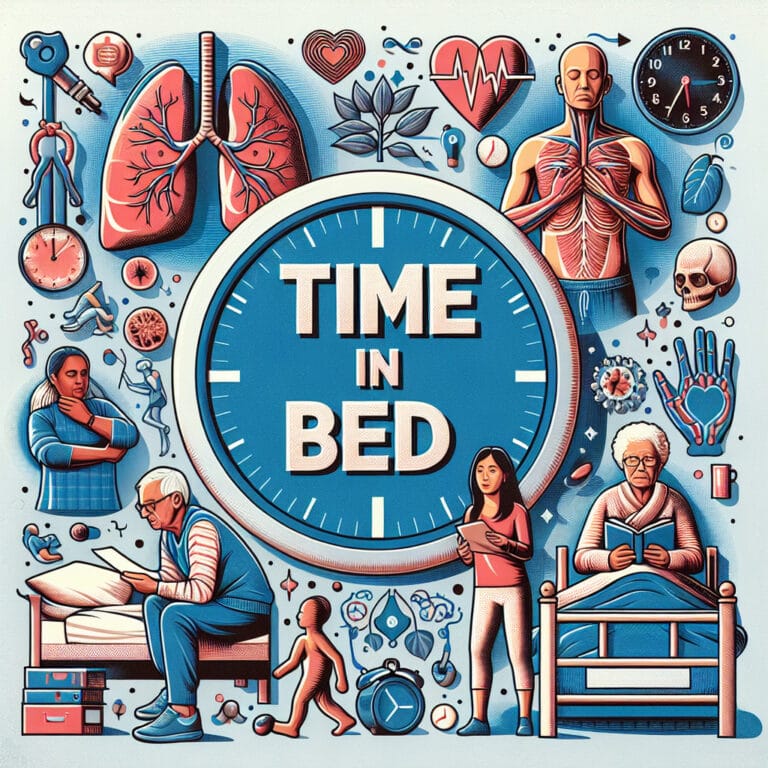
Unraveling the Mystery: What Exactly Does ‘Time in Bed’ Mean?
Table of Contents
- Introduction
- Definition of ‘Time in Bed’
- Factors affecting ‘Time in Bed’
- The Importance of ‘Time in Bed’
- How to Optimize ‘Time in Bed’
- Conclusion
- Frequently Asked Questions
Introduction
A surprising fact about ‘Time in Bed’ is that it doesn’t necessarily equate to how much sleep you’re actually getting. It’s crucial to recognize the difference between time spent in bed and actual sleep time for optimizing health and wellness. Your ‘Time in Bed’ is influenced by multiple factors including age, lifestyle factors, and even underlying health conditions. As we age, our sleep patterns change, which can impact this duration. Similarly, late-night screen usage or an inconsistent sleep schedule may lead to longer ‘Time in Bed’ but lesser quality rest. Chronic health conditions like insomnia or sleep apnea also contribute significantly towards disrupted slumber patterns leading to increased time spent awake in bed.
Understanding your ‘Time in Bed’ has numerous health benefits; foremost being a positive impact on productivity due to enhanced restfulness. Moreover, there’s a direct relationship with sleep quality – maintaining a consistent and fixed sleep schedule ensures better REM cycles leading to improved overall well-being.
Improving your ‘Time in Bed’ isn’t rocket science – some tips include adhering to good sleeping hygiene practices such as ensuring a conducive environment for rest (think cool room temperature and comfortable bedding), minimizing stress levels prior bedtime with relaxation techniques like meditating or reading, avoiding caffeine intake close to bedtime among others.
In conclusion, recognizing the importance of understanding your ‘Time In Bed’, its influences along with strategies for optimization are key components of maintaining balanced health & wellness.
Definition of ‘Time in Bed’
It’s intriguing to explore the nuances between ‘Time in Bed’ and ‘Sleep Time’ – two terms that are often confused but carry different connotations. When we refer to ‘Time in Bed’, it encapsulates the entire duration spent resting on the bed, even if you’re awake. On the other hand, ‘Sleep Time’ strictly refers to the period during which one is actually asleep. The gap between these two can be influenced by various lifestyle factors such as late-night screen usage or stress levels prior bedtime.
Age and certain health conditions could also impact this difference, leading to either prolonged sleep latency (time taken to fall asleep) or frequent awakenings through the night. For instance, older adults might spend more time in bed but experience fragmented sleep due to age-related changes in sleep architecture.
Understanding this distinction carries significant health benefits as it allows us to monitor our restfulness better and adjust our routines for optimum productivity during waking hours. The relationship with sleep quality is direct; a shorter gap between ‘Time in Bed’ and actual ‘Sleep Time’ suggests better-quality rest with efficient REM cycles.
To bridge this gap, tips for improving sleep hygiene can be instrumental – maintaining a consistent and fixed sleep schedule aligns your body’s internal clock with natural day-night rhythms promoting sounder slumber; creating a conducive sleep environment free of noise or excessive light aids quicker onset of deep-sleep stages while minimizing stress through relaxation techniques encourages uninterrupted snooze sessions.
Factors affecting ‘Time in Bed’
Sleep scientists have found that ‘Time in Bed’ is a nuanced balance of numerous factors, among which lifestyle choices, health conditions, and age play key roles. Intriguingly, our own daily habits significantly shape the time we spend under the covers. Late-night binge-watching or work-related stress can leave us tossing and turning, prolonging our ‘Time in Bed’ without necessarily augmenting our ‘Sleep Time’. It’s vital to comprehend how such elements may inadvertently extend your hours in bed while reducing the quality of rest obtained.
Health conditions too cast their shadow on this delicate balance. Insomnia or sleep apnea sufferers often find themselves languishing awake at night despite being tucked in bed. This not only disrupts their sleep pattern but also inflates their overall ‘Time in Bed’, leading to potential health repercussions and productivity loss during daytime activities.
Moreover, as we journey through different stages of life, our sleep needs also evolve. Children require ample slumber for development and growth while adults strive for a restorative snooze to function optimally. As we age further into twilight years, changes within our internal biological clock coupled with certain ailments often lead to fragmented sleep spells resulting in elongated periods spent resting without effectively sleeping.
The silver lining here is that understanding these influences offer pathways towards better sleep hygiene practices. Maintaining a consistent sleep schedule aligned with natural day-night cycles can help optimize both time and quality of rest achieved; creating a conducive environment free from noise or light distractions promotes quicker onset of deep-sleep stages; managing stress effectively ensures uninterrupted slumber leading to enhanced overall well-being – benefits serving as catalysts for improved productivity and vitality!
| Factor | Description | Effects on ‘Time in Bed’ |
|---|---|---|
| Lifestyle Choices | Late-night activities like binge-watching or work-related stress | Can prolong ‘Time in Bed’ without necessarily increasing ‘Sleep Time’ |
| Health Conditions | Conditions like insomnia or sleep apnea | Disrupts sleep pattern and can inflate overall ‘Time in Bed’ |
| Age | Changes in sleep needs across different stages of life | Can lead to more time spent in bed without effectively sleeping due to fragmented sleep spells |
| Sleep Hygiene Practices | Practices like maintaining a consistent sleep schedule, creating a conducive environment, and managing stress | Can optimize both time and quality of rest, leading to enhanced overall well-being and productivity |
The Importance of ‘Time in Bed’
A surprising fact to consider is that there’s more to ‘Time in Bed’ than meets the eye. The hours we spend under the covers are not just about sleep duration, but quality as well. An insight often overlooked is how this time can directly influence our productivity and overall health benefits. It’s essential not to confuse ‘Time in Bed’ with ‘Sleep Time’. While both play pivotal roles in our wellness journey, they represent differing aspects of restfulness. The former encapsulates the total duration spent on bedding, regardless of consciousness state; while the latter speaks strictly to periods we’re actually asleep.
Influential facets such as lifestyle factors, underlying health conditions and age have a significant impact on these parameters. For instance, an adult engrossed in late-night screen usage may find themselves spending longer periods in bed without necessarily achieving quality slumber – a prime example of how lifestyle habits can inflate ‘Time in Bed’, yet deflate sleep value. Hence, it’s crucial to strike a balance between both concepts.
Optimizing ‘Time In Bed’ isn’t merely about increasing hours spent resting but ensuring efficient use of this duration for restorative sleep. Following tips for improving sleep hygiene like maintaining a consistent or fixed sleep schedule aligned with natural circadian rhythms coupled with creating a conducive environment free from distractions promises better REM cycles implying improved overall vitality! Through these mindful practices, you can harness your ‘Time In Bed’ effectively turning it into an ally for amplified productivity and enhanced well-being.
How to Optimize ‘Time in Bed’
Delving deeper into understanding ‘Time in Bed’ uncovers the influence of various lifestyle factors, health conditions, and age on this integral aspect of our wellness journey. This concept is not just about the duration spent resting but also holds a direct relationship with sleep quality. Your ‘Time in Bed’ can be an accurate reflection of your overall health benefits and even impact your productivity levels. An eye-opening fact is that sometimes we may spend ample time in bed but fail to get a restful night’s sleep due to late-night activities or stressors; leading to reduced actual ‘Sleep Time’. Fortunately, there are practical tips for improving sleep hygiene that can help optimize this crucial time.
One key strategy includes maintaining a consistent and fixed sleep schedule which aligns your body’s internal clock with natural circadian rhythms, promoting better REM cycles. Furthermore, cultivating a conducive sleep environment – free from noise distractions or excessive light – aids in quicker onset of deep-sleep stages ensuring efficient use of your ‘Time In Bed’. By integrating these mindful practices into routine, you’re set on the path towards achieving enhanced vitality and amplified productivity.
Conclusion
Harnessing the importance of ‘Time in Bed’ can be a game-changer for health and productivity. This vital aspect, often overlooked, goes beyond mere sleep duration – it’s about the quality of rest obtained during this time. With lifestyle factors, age and health conditions influencing both ‘Time in Bed’ and ‘Sleep Time’, understanding their interplay is crucial to unlock potential health benefits. Prioritizing good sleep hygiene practices like maintaining a consistent or fixed sleep schedule and creating a conducive sleep environment can optimize your ‘Time in Bed’, leading to improved sleep quality. Remember, an investment in understanding your rest patterns is an investment in enhanced well-being and productivity.



